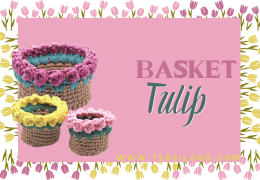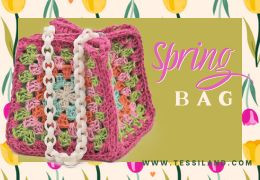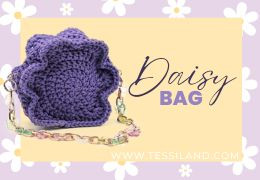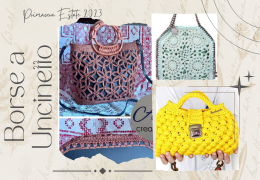Discover the handmade crochet trends for Spring/Summer 2025: colors, must-have pieces, and crochet accessories for a...
0 prodotti 0
Your cart is empty
Search in blog
Blog categories
Latest posts
-
 The Spring/Summer 2025 trends every fashion lover needs to know.Read more
The Spring/Summer 2025 trends every fashion lover needs to know.Read more -
 Tulip Crochet Basket13/04/2025Read more
Tulip Crochet Basket13/04/2025Read moreHow to Make a Tulip Crochet Basket. Creative ideas for spring and Easter with lycra tape and bubble stitch. Do you...
-
 SPRING BAG: the crochet bag that smells like spring.06/04/2025Read more
SPRING BAG: the crochet bag that smells like spring.06/04/2025Read moreA creative and colorful project for the sunny season. Handmade bags for Spring-Summer 2025.
-
 Daisy Crochet Bag: the trendiest crochet project of the moment.30/03/2025Read more
Daisy Crochet Bag: the trendiest crochet project of the moment.30/03/2025Read moreDaisy Crochet Bag: how to make the flower-shaped bag that's taking over social media. A creative, quick, and free...
-
 Snow White, the crochet amigurumi you have to make.21/03/2025Read more
Snow White, the crochet amigurumi you have to make.21/03/2025Read moreSnow White, between history and chenille twists. Create your own crocheted Snow White! To celebrate the release of...
Popular posts
-
 Crochet bags, the models for spring-summer.29/04/2023One of the most searched accessories on the web, patterns, tutorials, ideas, projects, accessories, here's how to...Read more
Crochet bags, the models for spring-summer.29/04/2023One of the most searched accessories on the web, patterns, tutorials, ideas, projects, accessories, here's how to...Read more -
 Crochet bags for spring summer 2024. 5 models of handmade sling bags.05/04/2024Discover the latest trends for Spring/Summer 2024 with our exclusive guide to 5 crochet sling bag models. Perfect for...Read more
Crochet bags for spring summer 2024. 5 models of handmade sling bags.05/04/2024Discover the latest trends for Spring/Summer 2024 with our exclusive guide to 5 crochet sling bag models. Perfect for...Read more -
 The Crochet Net Bucket Bag: A Trendy Accessory for 202401/06/2024Learn how to make a crochet net bucket bag with our simple and detailed tutorial. Use elastic cord, a size 5 crochet...Read more
The Crochet Net Bucket Bag: A Trendy Accessory for 202401/06/2024Learn how to make a crochet net bucket bag with our simple and detailed tutorial. Use elastic cord, a size 5 crochet...Read more -
 Crochet rugs, a passion that is becoming a trend.21/01/2024In this article, dive into the art of crochet rugs and discover how to create unique and personalized pieces for your...Read more
Crochet rugs, a passion that is becoming a trend.21/01/2024In this article, dive into the art of crochet rugs and discover how to create unique and personalized pieces for your...Read more -
 From runways to street style: the trendiest crochet bags.06/09/2023Are you also passionate about handmade items and want to create your own capsule collection of crochet bags? Here are...Read more
From runways to street style: the trendiest crochet bags.06/09/2023Are you also passionate about handmade items and want to create your own capsule collection of crochet bags? Here are...Read more
Itchy wool? Discover the remedies.
Itchy wool? Here’s what to know for wearing it without discomfort
If you love the warmth and softness of wool garments, but often find yourself giving up because of the itching and prickling it causes on your skin, this article is for you.
Let’s explore together why some types of wool cause discomfort and how you can make your handmade garments more comfortable, along with alternatives for those who are allergic or have particularly sensitive skin.
Why does wool itch? The main reasons
Not all wool is the same, and not all causes itching. The prickling sensation largely depends on the thickness and rigidity of wool fibers. Thicker and stiffer fibers, like those in traditional wool, stimulate the nerve endings on the skin more, causing a prickling sensation. The processing method and quality of the wool also matter: untreated wool can retain natural residues that irritate the skin.
Some types of wool, such as merino wool with very fine micron counts, have thinner and softer fibers, like JUSTIN BABY with 19.5 microns, which bend easily and are less irritating; they make the fiber thin and long because the twist prevents the hair from sticking out. This is why, often, those who suffer with traditional wool find merino wool, cashmere, or other fine and carefully crafted fibers much more comfortable.
Allergy or sensitive skin? Understanding the difference
.jpg)
It’s important to distinguish between a true wool allergy and particularly sensitive skin. Those with an allergy develop an immune response, with symptoms that can include skin rashes, intense redness, and severe itching. In these cases, it’s best to avoid wool entirely.
Skin sensitivity, on the other hand, is a milder reaction that depends on the skin’s tolerance threshold to fibers. Those with sensitive skin may feel prickling without having a true allergic reaction. In this case, some remedies can be adopted to make wool more comfortable.
Remedies for a more comfortable wool: how to treat handmade garments.
There are various methods to soften wool garments and reduce prickling, starting with the ''GRANDMOTHER'S REMEDIES'':
- Soak in vinegar or conditioner: After washing, leave the garment to soak in a solution of water and white vinegar, or add some hair conditioner. Both methods help soften the wool and reduce prickling.
- Freezing: Place the garment in a plastic bag and put it in the freezer for a few hours. The cold relaxes the fibers and can help reduce the stiffness that causes itching.
Then we move on to more professional remedies:
- Gentle washing: Use a specific wool detergent and wash garments by hand or with a gentle machine cycle. This softens the fibers and removes any irritating residues.
- Use of specific softeners: There are special softeners for wool garments that protect the fibers, making them more comfortable against the skin.
The best solution remains choosing MADE IN ITALY wools.
Alternatives to wool for those with sensitive skin or allergies.
If wool isn’t for you, don’t worry: there are several alternative fibers that offer warmth and softness without causing irritation. Here are some of the best:
- Cotton: Naturally hypoallergenic, cotton is one of the most versatile fibers. Although it isn’t as warm as wool, there are heavier and more textured versions perfect for winter.
- Acrylic: Often used as a wool alternative, acrylic is a soft and warm synthetic fiber. It’s suitable for those allergic to wool, though it doesn’t offer the same breathability.
- Bamboo or Tencel: This fiber is eco-friendly and has a smooth, silky texture, ideal for those with sensitive skin. Additionally, it’s thermoregulating, keeping you warm in winter and cool in summer.
- donny ecodonny
- bravissimo chuck
- tencel isac
Choose the right yarn for your skin.
If you have particularly sensitive skin or are allergic to wool, it’s worth experimenting with some of these alternative yarns. In DIY projects, always consider the softness and comfort of the yarn you choose, as a handmade garment should be a joy to wear.
Wearing wool without discomfort is possible! With a few precautions, you can soften your favorite garments and reduce prickling. And if wool just isn’t for you, there are plenty of alternatives.
Experiment with yarns, choose the one that best suits your needs, and enjoy the warmth of a comfortable, handmade garment.
Rosaria Tessiland®
.jpg)



